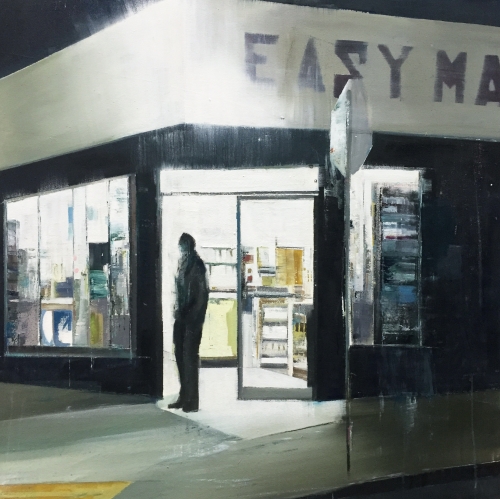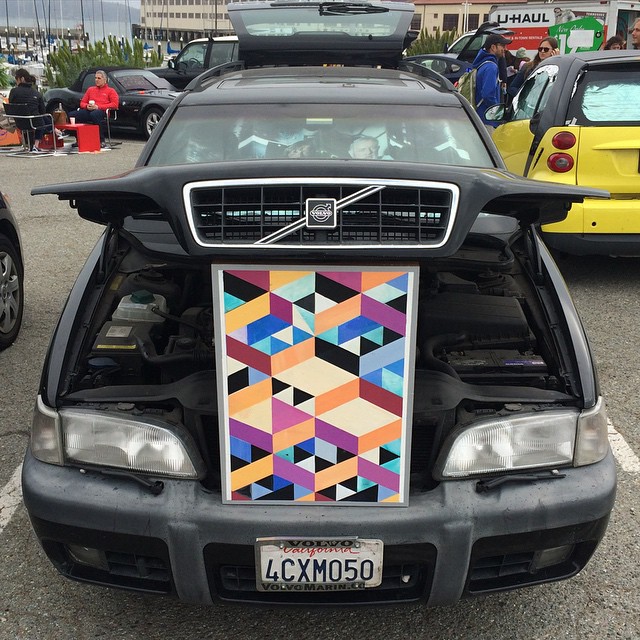The San Francisco art world is banding together to preserve what’s left of its community in a city that seems to increasingly seek to push the arts away: rents are sky high, evictions and displacement are common, but gallery owners and artists persevere.
Last week marked the fifth year of Art Market San Francisco, held at Fort Mason Center. With 25,000 people in attendance, Kelly Freeman of Art Market says it was a strong year, “Bay Area collectors have grown accustomed to art fairs and the galleries keep coming back.” The contemporary and modern art fair is the last still standing of the trio that once marked this season (ArtPadSF and the San Francisco Fine Art Fair are no more), but it was joined by two brand new fairs (stARTup Art Fair and the rogue Parking Lot Art Fair) in their place.
Though often over-stimulating and overwhelming for the viewer, art fairs continue to grow in popularity. Galleries pay tens of thousands of dollars to pack and ship works, fly their staff around the world and set up shop at fairs — in addition to paying rent at their brick and mortar locations. In a city like San Francisco where real estate is already costly, it’s not the best combination of expenses, but a necessary move.
Mark Pinsukanjana, co-owner of Themes + Projects gallery, says it’s difficult to survive solely off an exhibition space like he could ten years ago, “Times have changed… When you don’t have a brick and mortar, the art fair organizer won’t take you seriously.” Visitors pay the price, too. Admission into Art Market was $25.

Ken Harman is the owner of Hashimoto Contemporary and Spoke Art, two San Francisco galleries. Artists on display in the Hashimoto booth included GATS, John Wentz, Joel Daniel Phillips and Brett Amory. It’s Harman’s fourth year at Art Market and he says it’s absolutely worth the booth cost, “The galleries are on Sutter Street and while they get a fair amount of foot traffic, this type of event really is where you get to meet collectors from all over the city and in some instances, from all over the state.”
The same is true for galleries from across the Bay. Dasha Matsuura of Oakland’s Chandra Cerrito Contemporary says, “A lot of times San Francisco folks might not be as aware of Oakland galleries.” She admits that finding a good space is difficult in the Bay Area but she also adds, “I’ve never seen the amount of community, within galleries, that I’ve seen in Oakland.”
Maintaining a physical location with the right community is a struggle. Themes + Projects, a photography-based gallery and publisher, opened in 1999 as a bookstore in Palo Alto and was, until recently, among the tenants at 49 Geary. They are now slated to join a roster of galleries in the Minnesota Street Project, opening in 2016 in San Francisco’s Dogpatch neighborhood. Until then, Themes + Projects is an appointment-only operation.
For Pinsukanjana this move is about more than rent prices, “We truly believe in what they are doing at Minnesota.” The complex, led by art-world patrons Deborah and Andy Rappaport, is committed to maintaining San Francisco’s arts scene by providing affordable spaces for galleries and education programs for art lovers.
It’s an exciting development for a few lucky tenants, but for most galleries, it’s unclear what the future holds. Ken Harman says time will tell, “A lot of my artists, especially in the last three years, have begun to relocate from San Francisco, some are moving to L.A., some are moving to Oakland or the East Bay. It’s definitely affecting us personally.”

Christian Davies, artist and co-director of Adobe Books Backroom Gallery, relocated to Oakland to find affordable live/work space after 12 years in San Francisco. “I don’t think I want to get on the whole ‘it sucks’ bandwagon because it is what it is,” he says. “Artists are going to find their way. We’re going to do things like show up in a parking lot and have an art fair in response to art fair fees.”
Which is exactly what they did.
Davies filled his station wagon with paintings and showed up outside Fort Mason at 6:30am on Saturday morning for the Parking Lot Art Fair, a DIY event organized by Emily Reynolds and Jenny Sharaf. “It was kind of like a company picnic, if that company was art,” Davies reports. The participating artists gathered to share and appreciate one another’s work — free of charge — in direct response to the weekend’s ‘official’ art fairs. “It cost me a quarter tank of gas and a sandwich and some beer,” Davies boasted.
Davies was accompanied by friend Sera Mac, a San Francisco artist and writer. Compared to the slick, pristine scene inside Art Market, Mac says, “[The Parking Lot Art Fair] was a little irreverent, and more messy and raw.”
The whimsical experience of the Parking Lot Art Fair was far from Art Market’s smart and polished environment, where price tags started in the low thousands and went upwards of six figures. The two represent very different arts economies — one based on trade and mutual support, the other on the commercial art market — yet both are necessary to a healthy art scene in the Bay Area, and, perhaps hopefully, both were well attended, often by the same crowds of art appreciators and supporters.